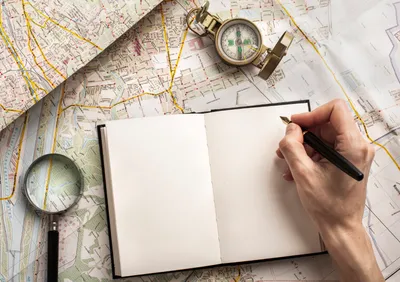Issue 13
August 2025
Theme Machine
Tale Trekkers
Send a postcard home from your holiday adventures and discover inspiration for unusual story locations.
- Choose a postcard
- Fill it with images
- Get back a "message"
Research Corner
The Armchair Traveler's Guide to World-Building
Traveling for research isn’t always possible due to budget, health, or family commitments. But thankfully, there’s alternatives! Moving beyond generic travel sites can help you find authentic details to make your setting feel real:
- Start with Google Street View to understand an area’s layout, then search those places on Instagram or TikTok. You can see the location through the eyes of its residents and what they find interesting.
- Find city-specific subreddits or local Facebook groups. This is where people ask about daily life, and you may even learn about some local lore that travel guides may have missed.
- On YouTube, search for a “[city name] walking tour.” These videos often have no narration, just the raw sights and sounds of daily life: ambient noise, overheard conversations, and the rhythm of the streets.
- Engage your senses by trying recipes for popular local street food or listen to a local radio station online (radio.garden is like Google Maps, but for radio stations!). Hearing the music and language is a great way to grasp the culture in action.
Pick a technique, and see how it can make your story feel more alive and in-depth. Maybe you find a nugget of inspiration to solve plot holes, spot inaccuracies in locations, or tweak character behavior you might have missed otherwise.
Help for Writers
Taking a Break
Sometimes the best way to find inspiration is to stop hunting for it. A vacation can be the perfect time to let your creative energy recharge by gathering new experiences. Your subconscious is brilliant at making surprising connections when you give it space to wander, so new inputs often lead to fresh ideas:
- Engage your senses. Why not try some local dishes? Depending on where you go, there might be a music festival, botanical gardens, or a petting zoo. Fresh sensory input can lead to unexpected story ideas.
- You don’t even have to travel far for a new perspective. You might visit that museum you’ve always passed by or explore a park in a neighborhood you’re unfamiliar with. Adventure doesn’t always require a passport.
- Stretch your storytelling muscles with small exercises. While at a coffee shop or park (or just from a YouTube video), you could pick a stranger and invent their secret. What’s in that overstuffed bag? Imagining backstories for people you see is a great way to build your character-creation skills.
Novelcrafter Secrets
Keeping track of your locations
Ever lose track of which characters have been to which inn, or where a specific event took place? Seeing your story’s journey laid out visually can be a great help. Novelcrafter offers two powerful ways to track your locations.
For rich, context-aware tracking, link a location’s Codex entry directly to your scenes:
- Use the + Codex button under your scene summary to establish the connection.
- This adds information related to that location to every scene beat within the scene.
- In the matrix view you can map out where each location is mentioned in your story.
If you don’t want the AI to use your locations in the prose, and/or want the tracking to be just for your own planning, you can also use Scene Labels. In your novel settings, you can create custom labels for key locations you want to focus on.
Do note, that when you use AI, neither of these tricks automatically tell it that your entire scene happens in that location. You’ll still want to mention the setting and any important details in your scene’s summary and/or beats to get the best results.

